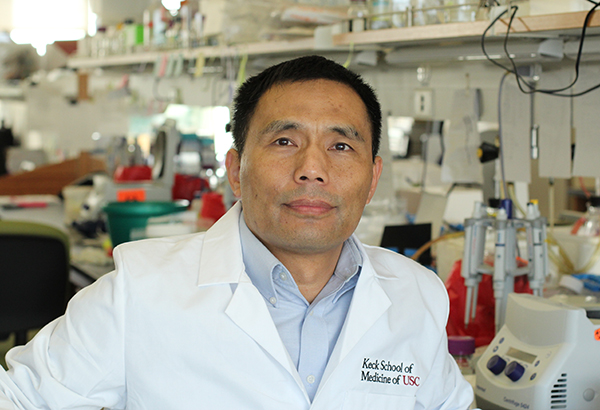
Groundbreaking research by Keck School of Medicine of USC researchers has been selected as one of Science magazine’s top 10 Breakthroughs of 2010.
The study, Production of p53 gene knockout rats by homologous recombination in embryonic stem cells, marked the first time that “knockout” rats—animals genetically modified to lack one or more genes—had been generated through embryonic stem (ES) cell-based gene targeting. The long-awaited achievement provides scientists with a far more effective animal model to study a range of human diseases. The research was published in the Aug. 11 edition of the journal Nature. The principal investigator is Qi-Long Ying.
“This accolade indicates the importance of this advance to biomedical research and its likely impact on many fields of study,” said Martin Pera, director of the Eli and Edythe Broad CIRM Center for Regenerative Medicine and Stem Cell Research at USC. “Past discoveries that have been recognized as Breakthroughs of the Year by Science include cell reprogramming, climate change research, and the multiple roles of noncoding DNA. I am delighted that the rat stem cell technology, based on years of work by Qi-Long’s lab, has achieved this level of international recognition.”
The development of knockout rats will have a significant impact on biomedical research because the rat physiology is much more closely related to humans than mice in many aspects of biology. Also, rat models more closely mimic human diseases in many areas such as cardiovascular disease, neurodegenerative disease, nephropathy, obesity, and breast cancer.
Science magazine listed USC’s achievement in a Dec. 17 article recognizing achievements in areas from genomics to cosmology. USC’s achievement is listed under “Rats Redux:”
“In 2009, researchers adapted to rats a method, previously used in fruit flies and zebrafish, that uses enzymes called zinc finger nucleases to knock out genes,” the article states. “In August, another group announced a tweak that produced ‘knockout rats’ by the same genetic trick used for knockout mice. Also this year, several groups reported advances in using transposons, DNA sequences that jump from one location to another within a genome, to generate rats with genetic mutations—animals useful for developmental biology and disease research. As a result of such techniques, knockout and genetically modified rats may soon displace their smaller cousins in lab cages around the world.”
Science magazine editors compiled a list of groundbreaking achievements during the year and asked select experts in the science and research fields to add their choices. Robert Coontz, deputy news editor for physical sciences at Science, said the USC research made it onto the list because of its significance to scientists.
“People have been trying to develop ‘knockout’ rats for years,” he said. “This is something that the scientific community wanted very much, and will affect scientific research in a big way.”
Keck School Dean Carmen A. Puliafito pointed to Ying’s research as key resource in the medical community’s efforts to save lives.
“It is an honor to have a highly respected publication like Science recognize this research among the best of the year,” said Puliafito. “Principal investigator Qui-Long Ying and his team deserve this recognition for providing the scientific community with a critical resource that will help other researchers develop cures for devastating diseases.”
